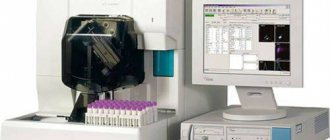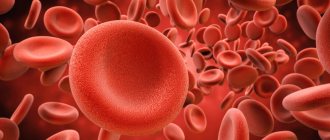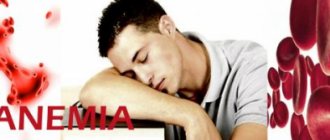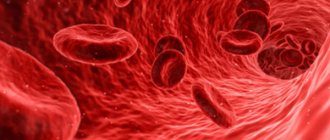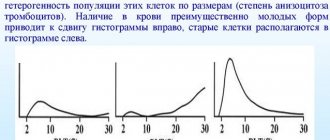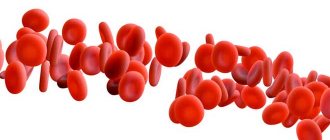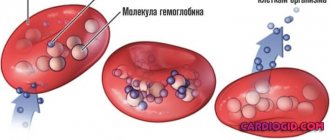General information about red blood cells
Red blood cells are red blood cells that are produced by red bone marrow.
Life expectancy is from 90 to 120 days, after which they undergo hemolysis (destruction) in the cells of the liver and spleen. In red bone marrow, cells go through several stages of development and differentiation. The cells contain a pigment - hemoglobin, due to which red blood cells have a red color. The main function is the transfer of oxygen and carbon dioxide. On the surface of the cells there are specific antigens - blood group factors (Kell, Duffy, Kidd antigen, Rh factor, AB0). Due to antigens, red blood cells stick together under the action of various antibodies (during transfusion of incompatible blood, exposure to a number of bacteria, viruses and others). The change in the size of red blood cells is called anisocytosis. Normally, their shape is round and biconcave.
The normal cell diameter is from 6.9 to 7.5 µm. Normally, the number of standard cells in diameter should not decrease less than 70%. The presence of 30% of cells increased or decreased in size is allowed (standard deviation, which can be observed in people after blood transfusions or operations). Depending on the size of red blood cells, there are 4 types of anisocytosis:
- microcytosis – cell size less than 6.9 microns;
- macrocytosis – more than 7.5 µm;
- megalocytosis – more than 12 microns;
- mixed form - the presence of large and small cells.
Depending on the percentage of altered erythrocytes, there are 4 degrees of severity of anisocytosis: insignificant (less than 25% of altered cells of the total number of erythrocytes), moderate (up to 50%), severe (up to 75%), critical (over 75%).
Important! With a pronounced degree of change in erythrocytes, debris and fragments of erythrocyte cells are additionally determined in the blood (schizocytosis).
What is red blood cell distribution width RDW?
Of course, the basis of blood is erythrocytes or red blood cells. This is why our blood is red. Red blood cells have very important responsibilities in the body: saturate it with oxygen, maintain acid and alkaline balance and isotonia, remove CO2 (carbon dioxide) from organs and tissues, and much more. Hemoglobin, which is a significant part of the red blood cell, performs similar functions. Therefore, when taking a clinical blood test, some erythrocyte indices are checked, one of them is the erythrocyte distribution width (RDW). This parameter represents the level of heterogeneity of red cells, as well as how different red blood cells are from each other. RDW is measured by a special hematology device, the result is recorded as a percentage.
The normal RDW for an adult is considered to be 11.5-14.5%, and for children under 6 months the norm is set in the range of 14.9-18.7%, and after 6 months - 11.6-14.8%.
For example, if the width of the distribution of red blood cells is increased, this means that the cells greatly exceed each other in size, their life span is significantly reduced, and the overall number of cells is disrupted. When the width of the distribution of red blood cells is below normal, this indicates slow blood formation and may indicate the presence of anemia (anemia) of any degree.
Any deviation from the norm can lead to various problems and diseases, depending on their nature and severity, and are the basis for additional examination and identification of the cause. But, in any case, the only correct conclusion can only be made by a qualified, experienced specialist.
Characteristics of the indicator
RDW reflects how equal all red blood cells are in volume. Most often, the size of the corpuscle changes with anemia, proliferative changes, in which red blood cells become larger or smaller in volume. When diagnosing bone marrow diseases and anemia, 2 indices of red blood cell distribution are determined: RDW-CV, RDW-SD. The first indicator is the size coefficient, the second is the relative distribution of red blood cells by volume.
RDW-CV is indicated as a percentage; before calculating the index, a graph of the distribution of red blood cells by value is plotted. The index is calculated using a special formula; if it is elevated, this can mean both an increase in microcytes and macrocytes (small, large cells). RDW-SD is calculated by a special analyzer, which produces the result in the form of a histogram, which indicates the difference between the largest and smallest red blood cells.
The changed indicator does not indicate any specific disease, therefore, during diagnosis, other cell characteristics are also determined:
- Average cell volume (MCV) - calculated using formulas using analyzers.
- Mean hemoglobin content (MCH). The index corresponds to the color index.
- Mean hemoglobin concentration (MCHC). Unlike the previous index, the amount of hemoglobin is not taken into account; only the density of filling the red blood cell with it is calculated.
Determining all indices allows you to obtain accurate information about the state of cells and determine the cause of anemia.
Important! Red blood cell indices are often prescribed to determine the effectiveness of treatment for anemic conditions.
What is red blood cell distribution width RDW?
Of course, the basis of blood is erythrocytes or red blood cells. This is why our blood is red. Red blood cells have very important responsibilities in the body: saturate it with oxygen, maintain acid and alkaline balance and isotonia, remove CO2 (carbon dioxide) from organs and tissues, and much more. Hemoglobin, which is a significant part of the red blood cell, performs similar functions. Therefore, when taking a clinical blood test, some erythrocyte indices are checked, one of them is the erythrocyte distribution width (RDW). This parameter represents the level of heterogeneity of red cells, as well as how different red blood cells are from each other. RDW is measured by a special hematology device, the result is recorded as a percentage.
The normal RDW for an adult is considered to be 11.5-14.5%, and for children under 6 months the norm is set in the range of 14.9-18.7%, and after 6 months - 11.6-14.8%.
For example, if the width of the distribution of red blood cells is increased, this means that the cells greatly exceed each other in size, their life span is significantly reduced, and the overall number of cells is disrupted. When the width of the distribution of red blood cells is below normal, this indicates slow blood formation and may indicate the presence of anemia (anemia) of any degree.
Any deviation from the norm can lead to various problems and diseases, depending on their nature and severity, and are the basis for additional examination and identification of the cause. But, in any case, the only correct conclusion can only be made by a qualified, experienced specialist.
Analysis transcript
In the absence of diseases, red blood cells have the same shape, volume, and color. If the width of the distribution of red blood cells by volume is higher than normal, this means that the sizes of the cells differ and their life expectancy decreases. If the erythrocyte distribution index is reduced, it means that the amount of hemoglobin in the cells decreases, which more often indicates anemia. The table shows the main indicators associated with red blood cells.
| Index | Normal values in adults |
| Hemoglobin (Hgb), g/l | 120-140 |
| Red blood cell count (RBC), 10¹²/l | 3.8-4.9 |
| Mean erythrocyte volume (MCV), µm | 82-98 |
| Average hemoglobin content in erythrocytes (MCH), pg | 26-31 |
| Average erythrocyte hemoglobin concentration (MCHC), % | 31-37 |
| Red blood cell distribution width by volume (RDW), % | 11.3-14.5 |
| Hematocrit (Ht), % | 37-47 |
In pregnant women, the breadth of distribution depends on the trimester of pregnancy:
- in the first – 11.2-15%;
- in the second – 12.1-14.8%;
- in the third – 11.3-16.4%.
The indicators may vary slightly depending on the reagent used in the laboratory, therefore the norm is always indicated on the form with the calculated indicators.
What is red blood cell distribution width RDW?
Of course, the basis of blood is erythrocytes or red blood cells. This is why our blood is red. Red blood cells have very important responsibilities in the body: saturate it with oxygen, maintain acid and alkaline balance and isotonia, remove CO2 (carbon dioxide) from organs and tissues, and much more. Hemoglobin, which is a significant part of the red blood cell, performs similar functions. Therefore, when taking a clinical blood test, some erythrocyte indices are checked, one of them is the erythrocyte distribution width (RDW). This parameter represents the level of heterogeneity of red cells, as well as how different red blood cells are from each other. RDW is measured by a special hematology device, the result is recorded as a percentage.
The normal RDW for an adult is considered to be 11.5-14.5%, and for children under 6 months the norm is set in the range of 14.9-18.7%, and after 6 months - 11.6-14.8%.
For example, if the width of the distribution of red blood cells is increased, this means that the cells greatly exceed each other in size, their life span is significantly reduced, and the overall number of cells is disrupted. When the width of the distribution of red blood cells is below normal, this indicates slow blood formation and may indicate the presence of anemia (anemia) of any degree.
Any deviation from the norm can lead to various problems and diseases, depending on their nature and severity, and are the basis for additional examination and identification of the cause. But, in any case, the only correct conclusion can only be made by a qualified, experienced specialist.
Increasing the indicator
If the index is elevated, this indicates an increase in the level of macroerythrocytes; accordingly, a shift to the right will be observed in the histogram. If only the width of distribution is increased, the cause is often anemia and a lack of vitamin B12. If there is an increase in MCV, the cause may be:
- hemolytic anemia;
- lack of vitamin B12;
- adhesion of red blood cells when exposed to cold (cold agglutination);
- liver pathologies.
If the distribution width is increased and the average volume index is decreased, the cause is often: thalassemia, iron deficiency. If, against the background of an increased indicator, destruction of erythrocyte cells is observed, this may be due to excess bilirubin, iron, and an increase in the volume of the spleen. Reasons for increasing RDW depending on cell size:
- With microcytosis – the predominance of small forms of erythrocytes. Observed in iron deficiency conditions, sickle cell anemia.
- With macrocytosis – large red blood cells are detected. Such cells are found with a lack of vitamin B12, folic acid, liver pathologies, myelodysplastic syndrome, autoimmune anemia and after chemotherapy.
- With normal cell sizes - occurs in chronic liver diseases, deformed, sickle cell anemia, deficiency of iron, B vitamins, folic acid.
In addition to deficiency of vitamins, iron, and anemia, the following can lead to an increase in the indicator:
- Inflammatory diseases. Against this background, the level of cytokines increases, which can inhibit the production of red blood cells and increase RDW. With chronic inflammation and the spread of infection, oxidative processes intensify, which reduces the life expectancy of red blood cells. Most often, the indicator increases against the background of polycystic ovary syndrome and inflammatory processes in the intestines.
- Blood transfusion - When large volumes of blood are administered or frequent transfusions are used, the width of distribution increases due to differences in the composition of the cells of the recipient and the donor.
- Kidney diseases. In renal pathology, a change in the level of erythropoietin is observed, which affects the RDW indicator.
- Alcohol abuse. Ethyl alcohol has a toxic effect on red blood cells, so the distribution width changes.
- Malignant tumors. In cancer, an increase in RDW is often detected, the degree of increase depends on the type of cancer cells and the presence of metastases.
- Autoimmune diseases - systemic scleroderma, ankylosing spondylitis, rheumatoid arthritis, psoriasis, Sjögren's syndrome.
- Diseases of the cardiovascular system. An increase in RDW is observed against the background of coronary heart disease, atrial fibrillation, acute coronary syndrome, and hypertension.
The relative width of the distribution of erythrocytes by volume can be increased due to hereditary spherocytosis, in which erythrocyte cells are deformed and change in volume.
Important! Scientists have conducted research on the effect of sleep on the index level. According to the results, a high probability of increased RDW is observed in people with a sleep duration of more than 10 hours.
The width of the distribution of red blood cells by volume is increased
The condition when RDW is significantly higher than normal is called anisocytosis. As already mentioned, this is not an independent disease, but only a factor of a specific cause.
When the width of the distribution of red blood cells by volume is increased, this means that red blood cells are different in diameter, there are normocytes with a diameter of 7-9 microns, microcytes - up to 6.9 microns, macrocytes - from 8 microns, and megacytes - from 12 microns.
Erythrocyte anisocytosis has 3 degrees of severity:
- I degree - when 30-50% of all blood cells have a different size; II degree - the diameter of 50-70% of red blood cells is changed; III degree - more than 70% of all blood cells are transformed.
When the relative width of the distribution of red blood cells by volume is increased, red blood cells live a very short life, and when there are a large number of destroyed red blood cells, a lot of iron and bilirubin accumulate. These substances subsequently enter the liver for modification and processing. Thus, the organ is heavily overloaded, and therefore poorly performs its other functions.
In addition, the spleen increases in size, which is responsible for getting rid of destroyed blood cells and replenishing new ones. In such a situation, the load on the spleen is simply enormous, so much so that nearby neighboring organs, such as the stomach or intestines, may be damaged.
The main reasons for increased distribution width of erythrocytes in volume:
- acute liver diseases; Lack of vit. A and B12; iron deficiency and folate deficiency anemia; oncological formations; alcoholism; leukocytosis; hemolytic crisis.
Also, the width of the distribution of erythrocytes in terms of volume above normal occurs in synthetic poisoning, diseases of the heart and blood vessels, and bone marrow metaplasia.
Symptoms of anisacytosis
Due to the negative effect on the liver and spleen, a patient with a similar phenomenon may experience a yellowish skin color.
Another obvious sign is increased sweating, fatigue and drowsiness, weakness and loss of strength, and inability to perform prolonged work.
The nervous system may also be shaken, a person may be too excited in places, or, on the contrary, may seem indifferent and aloof.
In addition, the patient often experiences a rapid heartbeat, even in a state of calm, and shortness of breath.
Eyeballs, skin and nails become unhealthily pale.
Treatment of this condition usually comes down to eliminating the factors and causes of the appearance of differently sized cells. Sometimes, it’s enough to change your lifestyle a little, stick to the recommended diet and stop taking medications that contribute to a drop in Vit. B 12 in the body so that red blood cells return to normal.
Decrease in indicator
The width of the distribution of red blood cells by volume below normal is rare. As a rule, a decrease in RDW occurs against the background of:
- surgical treatment;
- pregnancy;
- frequent donation;
- period of puberty;
- taking contraceptives;
- dysfunction of the spleen;
- massive bleeding.
The cause may be cancer, such as leukemia. If RDW-CV decreases to 10%, both microcytic and macrocytic anemia may develop. That is, red blood cells of large or small size may predominate in the blood. Red blood cells of small diameter are observed in iron-saturated, iron-deficiency anemia. Large cell sizes are determined by deficiency of folic acid, copper, decreased thyroid function, liver disease, and impaired hematopoietic function.
The width of the distribution of red blood cells by volume is increased
The condition when RDW is significantly higher than normal is called anisocytosis. As already mentioned, this is not an independent disease, but only a factor of a specific cause.
When the width of the distribution of red blood cells by volume is increased, this means that red blood cells are different in diameter, there are normocytes with a diameter of 7-9 microns, microcytes - up to 6.9 microns, macrocytes - from 8 microns, and megacytes - from 12 microns.
Erythrocyte anisocytosis has 3 degrees of severity:
- I degree – when 30-50% of all blood cells have a different size;
- II degree - the diameter of 50-70% of red blood cells is changed;
- III degree - more than 70% of all blood cells are transformed.
When the relative width of the distribution of red blood cells by volume is increased, red blood cells live a very short life, and when there are a large number of destroyed red blood cells, a lot of iron and bilirubin accumulate. These substances subsequently enter the liver for modification and processing. Thus, the organ is heavily overloaded, and therefore poorly performs its other functions.
In addition, the spleen increases in size, which is responsible for getting rid of destroyed blood cells and replenishing new ones. In such a situation, the load on the spleen is simply enormous, so much so that nearby neighboring organs, such as the stomach or intestines, may be damaged.
The main reasons for increased distribution width of erythrocytes in volume:
- acute liver diseases;
- Lack of vit. A and B12;
- iron deficiency and folate deficiency anemia;
- oncological formations;
- alcoholism;
- leukocytosis;
- hemolytic crisis.
Also, the width of the distribution of erythrocytes in terms of volume above normal occurs in synthetic poisoning, diseases of the heart and blood vessels, and bone marrow metaplasia.
Symptoms of anisacytosis
Due to the negative effect on the liver and spleen, a patient with a similar phenomenon may experience a yellowish skin color.
Another obvious sign is increased sweating, fatigue and drowsiness, weakness and loss of strength, and inability to perform prolonged work.
The nervous system may also be shaken, a person may be too excited in places, or, on the contrary, may seem indifferent and aloof.
In addition, the patient often experiences a rapid heartbeat, even in a state of calm, and shortness of breath.
Eyeballs, skin and nails become unhealthily pale.
Treatment of this condition usually comes down to eliminating the factors and causes of the appearance of differently sized cells. Sometimes, it’s enough to change your lifestyle a little, stick to the recommended diet and stop taking medications that contribute to a drop in Vit. B 12 in the body so that red blood cells return to normal.
Index correction, prevention
Changes in the distribution width and size of red blood cells occur against the background of various diseases, so treatment is not aimed at correcting the level, but at eliminating the cause that led to this. Once the source is identified, appropriate treatment is prescribed. The most common cause is anemia, a lack of certain elements. In these cases, drugs that increase the level of hemoglobin, micro- and macroelements are indicated.
For oncological diseases, chemotherapy and radiation therapy are carried out, and surgical treatment if indicated. If thyroid function is impaired, use thyroid medications. If changes in erythrocyte indices are associated with hormonal imbalance, which is detected by laboratory tests, appropriate hormonal medications are prescribed. After the cause is eliminated, the indices return to normal.
The width of the distribution of red blood cells is one of the main characteristics of cells, which, together with other indices, helps determine the cause of the development of various anemias. Since many diseases can cause a change in the indicator, there is no specific prevention. They recommend standard preventive measures - timely diagnosis, treatment of diseases, adherence to a healthy lifestyle.
Lower RDW
Situations where the RDW indicator is reduced are rare. A deviation from the norm to a lesser extent indicates the development of dangerous diseases and pathological processes in the body that require diagnosis and immediate treatment.
Why is this happening
The resulting value is below normal means that red blood cells lose their function due to some congenital and acquired diseases. The main reasons why a reduced CV occurs in a blood test:
- Profuse bleeding due to injuries or wounds. Bleeding in the uterine cavity or stomach poses a threat to health, and in some cases, life.
- Previous surgical interventions, during which resection of an internal organ was performed.
- Disturbances in metabolic processes, as a result of which food entering the body is poorly digested and remains in the stomach, where it ferments, thereby provoking a purulent process.
- Changes in hormonal levels - this factor is typical for women.
- Low concentration of vitamins and iron.
- Blood diseases characterized by the loss of red blood cells of their functions.
- Oncological neoplasms, mainly tumors of the lungs and brain.
- Pathologies of an autoimmune nature, as a result of which new red blood cells do not receive enough important components, which affects their parameters and functionality.
Important information: What does increased lymphocytes in a child’s blood mean (reasons for increases)
The cause of low RDW may be anemia - microcytic hypochromic anemia. In this pathological process, red blood cells have an irregular shape, differ in size and quickly die due to the fact that such blood cells do not represent biological value in the body.
If there is a suspicion that the test result was false positive, the blood will have to be taken again, carefully following the doctor’s recommendations. Factors such as smoking before taking the test, excessive psycho-emotional arousal, and eating food immediately before taking biological material can affect the result of the analysis.
Taking certain medications can also cause a false positive result. Therefore, if a patient is forced to constantly take medications for medical reasons, the laboratory assistant must be informed about this.
How it manifests itself
Low RDW levels are manifested by:
- constant feeling of fatigue;
- lethargy and apathy, drowsiness;
- rapid fatigue even without physical activity;
- frequent attacks of dizziness;
- decreased degree of performance;
- shortness of breath;
- dry cough;
- increased blood pressure;
- rapid heartbeat.
All these signs arise due to disturbances in biological processes. Red blood cells become much smaller in size, which is why they cannot fully perform their functions. Due to their insufficient size, red blood cells cannot deliver enough oxygen to cells and soft tissues. First of all, the central nervous system suffers from this, which, due to a lack of oxygen, cannot fully transmit impulses along the nerve fibers.
If RDW is reduced in a blood test in a 3-month-old baby, this sign may indicate congenital blood diseases. If the indicator deviates from the norm to a lesser extent, first of all it is necessary to exclude a diagnostic error by retaking the analysis. If a repeat analysis again shows an abnormality, it is important to determine the cause, especially to pay attention to possible oncological neoplasms, most often accompanied by a low level of RDW.
Important information: What are red blood cells in the blood (what are red blood cells responsible for)
What to do
An underestimation of red blood cells in the blood is a rare phenomenon, but it signals dangerous diseases and pathological processes that can occur in a latent form until some point and do not have a pronounced symptomatic picture.
There is no single scheme of measures that can be used to increase the level of red blood cells. In order for RDW to be brought to normal levels, it is necessary to determine the cause of the deviations and eliminate it. Given the wide range of causes, therapy is selected individually.
Prevention
Cases where a low RDW result turns out to be only a diagnostic error occur more often than situations where severe illnesses lead to discrepancies with the norm. To avoid a false result, it is necessary to follow all recommendations regarding preparation for the process of collecting venous blood for analysis.
Low red blood cell distribution is a fairly rare phenomenon. It is difficult to prevent the occurrence of this pathological symptom. But some preventive measures will help, if you do not maintain health, then identify the disease in a timely manner and treat it at an early stage of development, avoiding complications.
Prevention of low RDW levels is a set of measures that help maintain good health and prevent the development of many diseases. Such measures include:
- A proper, balanced diet, including foods enriched with vitamins and minerals.
- Fractional meals so as not to put a strain on the organs of the digestive system.
- Maintaining an active lifestyle. It is necessary not only to exercise regularly, but also to take walks in the fresh air, which have a positive effect on the circulatory system and the heart muscle.
- Regular preventive examination.
Even if no symptoms bother you, it is important to undergo a medical examination and laboratory tests at least once a year. There are diseases that last for a long time without a pronounced symptomatic picture. They can be detected in the initial stages only through timely and regular blood tests.
The erythrocyte distribution index RDW SD is decreased or increased in a child, normal in a blood test
A general blood test is a mandatory diagnostic procedure for children.
It allows you to get acquainted with the characteristics of erythrocytes, leukocytes, platelets: their number, erythrocyte, leukocyte and platelet indices.
One of the parameters that UAC shows is RDW. Let's consider what this indicator means and whether you should worry if it is elevated or decreased in children.
RDW and its varieties
What is RDW? The abbreviation stands for Red Cell Distriburion Width. This is one of the general clinical blood test indices, indicating the distribution of red blood cells by volume. By deciphering the index readings, the laboratory technician identifies the presence of red blood cells, which vary in shape and size.
The task of red blood cells is to transport hemoglobin along with oxygen molecules. Successful functioning depends on the shape of the cell - a biconvex disk. The change in volume is called anisocytosis.
There are two varieties of RDW:
- rdw-cv - shows the severity of anisocytosis;
- rdv-sd - indicates the difference between the sizes of red blood cells.
RDW has a direct correlation with another UAC indicator - MCV. MCV index is the average volume of the red cell.
Purpose of the analysis
The erythrocyte index is included in the UAC. The attending physician can purposefully send a patient to donate blood if the following ailments are suspected:
- oncological pathologies;
- iron deficiency anemia;
- diabetes mellitus;
- liver damage.
Diagnosis of the erythrocyte count is indicated for the following symptoms:
- hereditary predisposition to thalassemia;
- lack of iron in the body;
- weakness, dizziness, hyperhidrosis and other signs of anemia;
- infectious diseases with a long course;
- profuse blood loss.
With pathologies of the form, blood cells cannot perform their main function - to carry oxygen to organs and remove waste products. RDW shows the percentage of red blood cells with a changed shape.
Normal indicators
What indicators are considered normal? The table provides information with a breakdown of the values of two types of index for children and adults:
| No. | Index | Meaning |
| 1 | RDW-SD | 39-46 femtoliters |
| 2 | RDW-CV | Adults - 10.9-15.6% |
| Children - 15-19.1% |
In some cases, additional diagnostics are required, since the value remains normal in some ailments:
- Spherocytosis. A hereditary pathology in which red blood cells are round rather than biconcave.
- Aplastic anemia. Stopping the growth and maturation of cells in the bone marrow. Without treatment, patients die within a few months.
- Some types of hemoglobinopathies. A congenital disorder of the structure of the hemoglobin protein, which causes pathology of red blood cells. This class of diseases includes sickle cell anemia and thalassemia.
What do increased readings mean?
The RDW index is elevated - what does this mean? An increase in the distribution of red blood cells by volume indicates various ailments of the circulatory system. To make a correct diagnosis you should always look at the MCV. The table shows the breakdown of analyzes when RDW is increased, depending on the MCV indicator:
| № | MCV increased | MCV is normal | MCV reduced |
| 1. | Liver damage due to alcohol abuse | The onset of iron deficiency anemia is a violation of hemoglobin synthesis due to a lack of iron in the body. | Iron-deficiency anemia |
| 2. | Hemolytic anemia - increased destruction of red blood cells | Macrocytic anemia | Thalassemia - decreased formation of polypeptide chains included in the structure of hemoglobin |
| 3. | Megaloblastic anemia due to deficiency of cyanocobalamine and folic acid. It is characterized by the presence of immature red blood cells - megaloblasts - in the hematopoietic brain. | — | — |
| 4. | Retinol hypovitaminosis | — | — |
What does it mean if the indicator is reduced?
What does it mean when RDW is below normal? As with an upgrade, if it's downgraded you should look at the MCV value:
- low MCV - pathology of the liver or spleen;
- high MCV - cancer lesions with metastases to the bone marrow.
If the index is down slightly, then you probably don't need to worry. It can fluctuate due to hormonal fluctuations during menstruation, after drinking alcohol or fatty foods. In infants the rate is slightly lower. This is normal and goes away after a few weeks; parents should not worry about their child.
Source: https://RosMedPlus.ru/diagnostika/krov/rdw-v-analize-krovi-povyshen-u-rebenka.html
The erythrocyte distribution index in a child is below normal - Medical method
When health does not allow one to enjoy life, and the first alarming symptoms appear, a sane person immediately turns to doctors for help. The first doctor is a therapist. It is he who assesses the general condition, makes the first conclusions, appointments, and examinations. The latter includes a general blood test.
A small procedure will help give an idea of what is happening to a person. Cholesterol, sugar, leukocytes are indicators known to most.
Abbreviation rdw in blood test - what is it? Naturally, the doctor will explain everything, but the incomprehensible Latin symbols - rdwsd and rdwcv - make you nervous and worried.
In order not to panic in vain, not to torment yourself with fears and horrors, you should broaden your horizons. First, it’s worth reading correctly: many people, out of fright, may miss a small letter, reading instead of the unknown rdw the known indicator RW.
Sexually transmitted diseases have a completely different direction. The rdw indicator in a blood test characterizes the quality of red cells, their shape, size.
For those who do not know about red blood cells and their role in the body, a short educational program is offered, after reading which the question will no longer arise: rdw in a blood test - what is it?
General information
Blood is a real chemical broth, but the main “residents” and “hard workers” are leukocytes and erythrocytes. Leukocytes can be compared to the body's guard. They are the ones who fight viruses, bacteria and other nasty things that try to destroy a person.
White blood cells are very important; a sharp increase or decrease in their number indicates danger, a threat to health. Red blood cells are also an important link. Red cells transport important oxygen throughout the body.
In fact, they are responsible for the fact that people breathe, move, and live.
The slightest deterioration in health, weakness, dizziness may indicate a change in the body, and a blood test will help you find out. Ideally, all components should not go much beyond the general framework, with the exception of pregnant women.
There must be a certain level of leukocytes, sugar, cholesterol, red blood cells. The last indicator is very important. The cells must be correct, oval in shape, fulfill their main task, and have the correct size.
It is the rdw indicator that indicates a change in red plaques, or more precisely, the distribution of red blood cells by volume. The normal size of an ideal cell is 7 – 9 microns.
Discs damaged by the disease change shape, become larger or smaller, and accordingly, it turns out that the relative width of the distribution of red blood cells over the volume is increased.
What does it mean? An ideal red blood cell is born in the bone marrow, grows, and does its job. In due time he dies in the liver. A red cell lives 60–80 days. Throughout her life she works, carries oxygen, works hard.
Accordingly, if the width of the distribution of red blood cells is increased, this indicates a serious threat to health.
Where to look for the reasons for changes in the blood base? The answer is banal - good nutrition is the key to health, because the composition of the cell depends on the vitamins, microelements, and minerals it receives. Bad habits also leave their negative mark: this is how low-quality blood cells are obtained.
Regular consumption of alcohol, or more precisely, ethyl alcohol, which is part of any fiery product, at the genetic level changes not only the distribution of red blood cells over blood volume. This is why there is a high rate of childhood congenital anomaly.
Pregnant women who regularly consume alcohol, drugs, and nicotine have a high risk of giving birth to a defective child.
Going deeper into medicine
The therapist, seeing some deviations, will definitely make you do an RDW blood test. If the red blood cells begin to change in volume, then this indicates the beginning of anisocytosis. This disease has 4 stages:
- The first degree will show a small number of changed cells - up to 50%, the lower figure - 24 - 25%.
- The second stage is characterized by an increase in the number of changed structures to 69–70%.
- The penultimate stage - the cells are changed by more than three quarters.
- The last level of the disease shows that there are no normal cells in the body.
The rdw blood clinic will show what stage the patient is at. The anisotropy coefficient of red blood cells shows the number of unequal red disks; in fact, the analysis sorts cells by size.
There is also an indicator rdwsd, which indicates the difference in red blood cells, that is, it finds the enlarged and smallest discs, shows the heterogeneity and size of the cell.
The second type - rdwcv blood test - is an indicator of the distribution of red blood cells by volume.
- The body lacks fluid.
- Hemoglobin is greatly reduced.
- The discs themselves change, which indicates oncology.
If rdw in a blood test is elevated, then you should pay attention to nutrition, vitamins, and metabolism. An increased width of distribution of erythrocytes indicates macroanacitosis. This is the phenomenon of red disks enlarged in volume. They owe their breadth to:
- vitamin B12 deficiency;
- diseases or tumors of the bone marrow;
- developing anemia;
- alcoholism;
- pregnancy.
If rdw is elevated in pregnant women, then expectant mothers should pay special attention to their diet: low hemoglobin leads to anemia and increases the risk of congenital diseases in the future baby.
In women, macroanacitosis can cause serious deviations in reproductive function, so those planning a family must do rdw in a general blood test before the perfect moment arrives.
If the baby has an increased rdw value, then perhaps this is the beginning of erythremia. A heart study should be performed; there is a possibility of developing blood diseases and dehydration of the small body. Children are not characterized by a high CV in a blood test, but parents should be aware that a low RDW in the blood indicates anemia.
Taking a blood test before breakfast in the morning will help detect the early development of the disease. The rate of red blood cells in a child’s blood before reaching the first year of his life should not increase from 11.6 to 14.8%. This level is normal for a healthy child.
An increase in the rdw indicator or a decrease in it indicates a high level of risk of developing the disease; it is necessary to undergo an examination.
The normal distribution of red blood cells by volume in an adult should be 11.5 – 14.6%.
In an adult, the level of distribution of red blood cells is reduced due to the small size of red cells; accordingly, the altered discs cannot cope with the function of transporting oxygen throughout the organs, they die, and new red blood cells do not have time to be born in their place. Oxygen starvation of all organs appears.
Values above the norm mean that the person is leading an incorrect lifestyle. An increased content of red cells also indicates the onset of liver disease, because this is where the blood disks end their journey.
